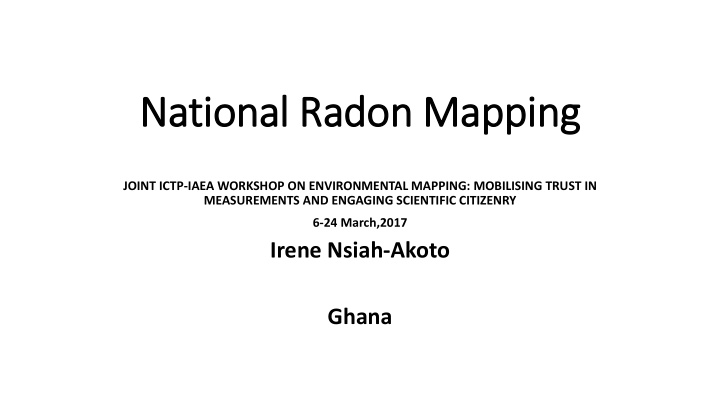



National Radon Mapping JOINT ICTP-IAEA WORKSHOP ON ENVIRONMENTAL MAPPING: MOBILISING TRUST IN MEASUREMENTS AND ENGAGING SCIENTIFIC CITIZENRY 6-24 March,2017 Irene Nsiah-Akoto Ghana
Ghana • officially the Republic of Ghana , is a unitary presidential constitutional democracy • located along the Gulf of Guinea and Atlantic Ocean, in the subregion of West Africa. Spanning a land mass of 238,535 km² • Ghana is bordered by the Ivory Coast in the west, Burkina Faso in the north, Togo in the east and the Gulf of Guinea and Atlantic Ocean in the south. • multicultural nation, has a population of approximately 27 million, spanning a variety of ethnic, linguistic and religious groups(GSS, 2014)
Why the National Radon Mapping • Killer gas at Dunkonah, June 2013 • In Ghana, activities leading to the emanation of radon and other decay products into the environment have not been extensively investigated and subjected to regulatory control. • Data on radon concentration in dwellings, soil, water and exposure of the population are very scanty. • There is general lack of knowledge and awareness of the radiological hazards by the public including legislators, regulators and decision makers
What are our main obje jectives • Map out the whole country to help identify the hotspots in the country • Raise public and political awareness about the consequences of exposure to radon; • Identify effective strategies for reducing the health of radon; • Promote sound policy options, prevention and mitigation programs to national authorities; • Estimate the global health impact of exposure to radon and allow resources to be allocated effective mitigate the health impact of radon; and • Create a database of radon exposure at the national and regional levels.
Sources of f data • Existing data • Collecting New data (Citizen Science) RAD7 by Durridge, USA LR 115 type II strippable by Dosirad France
Thank you
Recommend
More recommend